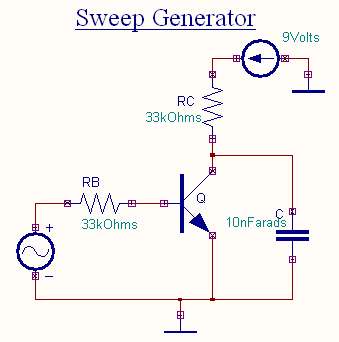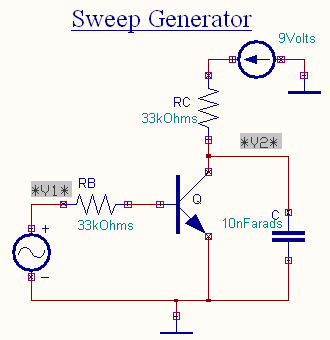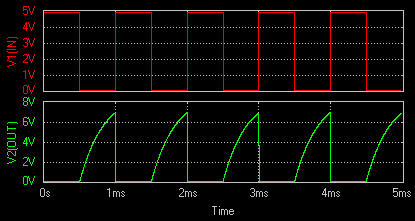Sweep Generator
Aim
To simulate a transistor sweep generator circuit.
Components
|
Name
|
EDWin Components Used |
Description |
Number of components required |
| TRANSISTOR |
BC107A |
NPN Transistor |
1 |
| RES |
RC05 |
Resistor |
2 |
| CAPACITOR |
CAP |
Capacitor |
1 |
| VGEN |
VGEN |
Voltage Generator |
1 |
| VDC |
VDC |
Voltage source |
1 |
| GND |
SPL0 |
Ground |
1 |
Theory

The circuit diagram of
a transistor sweep generator is shown in the figure. The performance of the
circuit can be explained as follows. During the positive half cycle
of the input signal the base-emitter junction of the transistor
becomes forward biased. The transistor conducts and is
driven into saturation. Then the output voltage will be low. During
the negative half cycle the base-emitter junction becomes reverse
biased and the transistor is driven into cut-off. During this
interval the collector of the transistor will be at a voltage slightly less than VCC.
The capacitor now charges towards this high voltage. During the next
positive half cycle the transistor turns ON and provides
the discharge path for the capacitor. The capacitor discharges
during the short time interval. Thus during the
positive half cycle the output of the circuit will be low and during the next half cycle we
obtain the sweep wave in the output. Hence the
name sweep generator for the circuit.
Procedure
EDWinXP -> Schematic Editor:
The circuit diagram is drawn by loading components from the
library. Wiring and proper net assignment
has been made. Values are assigned
for relevant components

EDWinXP -> Mixed Mode Simulator:
The circuit
is preprocessed. The waveform markers are placed at the input and output
of the circuit.
GND net is set as the reference
net. The Transient Analysis parameters are also set and the
Transient Analysis is executed. The output
waveform is observed in the
Waveform Viewer.
Result
The output waveform is observed in the waveform viewer.
